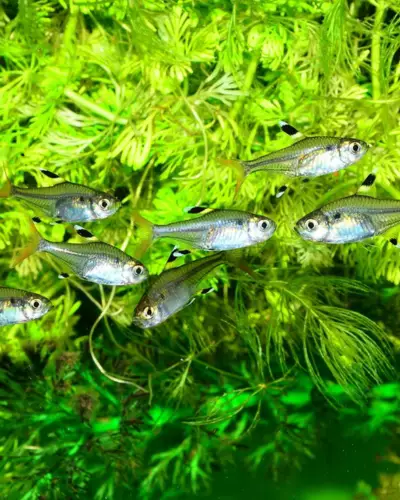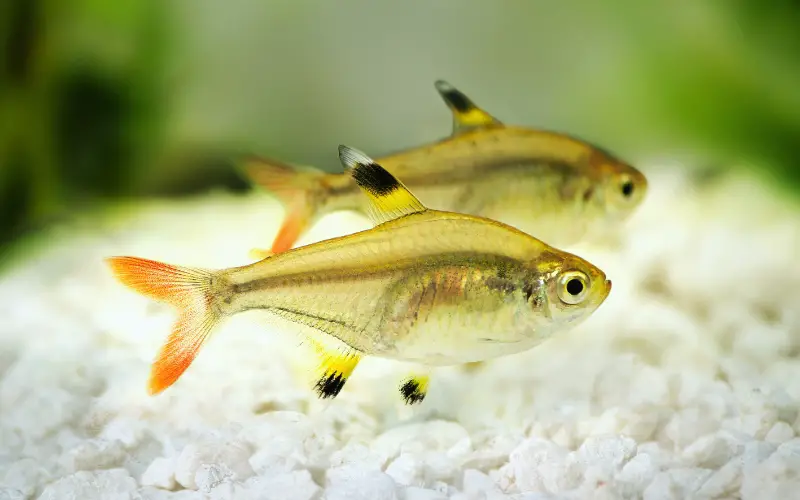With their transparent body, Pristella Tetras are popular freshwater fish in the aquarium hobby, known for their peaceful nature and striking appearance. One common question among aquarists is distinguishing between pristella tetra male vs female.
While these fish do not exhibit noticeable physical differences like some other tetra species, there are subtle characteristics that can help determine their gender.
In this article, we will explore the key traits to look for in male and female Pristella Tetras and tips on identifying their gender accurately.
By understanding these distinctions, hobbyists can better care for their fish and even breed them successfully.

Whether you are a beginner or an experienced aquarist, learning to differentiate between male and female Pristella Tetras can enhance your enjoyment of keeping these beautiful fish in your community aquarium.
Table of Contents
ToggleA brief overview of Pristella Tetra
Pristella Tetra, or Pristella maxillaris, is a popular choice for community tanks due to its small size, peaceful nature, and adaptability to various water conditions. These fish are typically found in the coastal waters of the Orinoco and Amazon, where they tend to shoal in large groups.
They have an ideal pH range of 6.0-7.5 and prefer soft, acidic water with sandy substrates and dense plant or driftwood cover.

The golden yellow translucent body with a black dorsal fin and distinct black stripe running from the eye to the tail makes them a striking addition to any aquarium. Sexual dimorphism can be noticed in the female’s thinner body and the male’s goldfinch coloration.
Pristella Tetras are known to be shy and may require a proper environment to feel secure. They will accept a variety of high-quality foods, but a balanced diet of flakes, pellets, and live or frozen food is recommended for optimal health and coloration.
Breeding is possible in a separate tank with proper conditions and a pair of mature, well-fed fish. The female will lay adhesive eggs on plant leaves, which will hatch in about 24 hours. After a few days, the fry will be free-swimming and can be fed infusoria or small commercial fry food.
Importance of Being Able to Identify Pristella Tetra Male Vs Female in Aquariums
Identifying male vs female Pristella Tetras (also known as Neon Lemon Tetras) isn’t essential for their primary care, but it can be helpful for a few reasons:
- Breeding: If you want to breed Pristella Tetras, you’ll need to be able to identify both males and females. Males will display brighter colors and chase females during breeding.
- Tank Harmony: Too many males in a tank can sometimes lead to aggression. Identifying the genders can help you create a balanced ratio.
- Appearance: While subtle, understanding the slight differences between males and females can help you appreciate the nuances of their appearance.
Here’s a breakdown of the key identifiers for Pristella Tetra sex:
- Body Size and Shape: Females tend to be slightly larger and rounder-bodied than males, especially when full of eggs.
- Fin Shape: Males may have a slightly larger dorsal fin than females.
- Coloration: Males tend to have a more vibrant red stripe along their body than females. This difference can be most noticeable during breeding times.
It’s important to note that these are general guidelines, and there can be some variation between individual fish. If you’re having trouble sexing your Pristella Tetras, you can try observing their behavior. Males tend to be more active and chase females around the planted tank.
Physical Differences Between Male and Female Pristella Tetras
Physical differences between pristella tetra male vs female can be observed in key ways. Firstly, male Pristella Tetras are typically smaller and more brightly colored than females.
Males also tend to have rounder bodies and more translucent fins than females. Another noticeable difference is the anal fin of the males, which is often more elongated and pointed than that of the females.
Regarding behavior, males may exhibit more aggressive tendencies, especially when trying to mate with a female. This can often be seen during spawning periods when males chase females around the aquarium.
It is also important to note that golden Pristella Tetras are shoaling fish and should be kept in a small group of at least five individuals to thrive.
Another exciting aspect of Pristella Tetras is their adaptable nature in biotope setup. These fish can be found in various habitats in the wild, including slow-moving rivers, streams, and tributaries, with moss and wood as part of the environment.
They are also known to prefer lighting that mimics natural sunlight. Regarding breeding, males will tag wherever the female releases her eggs with his sperm.
The eggs will hatch within a few days, and the fry will usually hang out near the water’s surface due to their swim bladder not fully developed at that age. Providing a filter with a gentle flow and maintaining stable water parameters are essential for the fry to survive.
Tips for identifying X-ray Tetra Male or Female
Identifying the sex of X-ray fish (Pristella maxillaris) can be tricky, as they don’t have the pronounced differences in other fish species. However, here are some tips that may help you distinguish between males and females:
General Observations:
- Size: Males are generally slightly smaller than females, but this difference can be subtle.
- Body Shape: Females tend to have a more rounded and fuller belly, especially when carrying eggs.
- Color: While not always reliable, some fishkeepers observe that males tend to have slightly more vibrant and intense colors, particularly in their fins.
Behavioral Clues:
- Aggression: Males are more prone to territorial behavior and may display aggression towards other males. They might chase each other or flare their fins.
- Courtship: During the breeding season, males may exhibit elaborate courtship displays involving fin-flashing and circling females.
Other Factors:
- Age: Sexing can be easier with older fish as the differences become more pronounced.
- Experience: With time and observation, you might develop an eye for the subtle differences between males and females.
Important Note: Sexing X-ray tetras can be challenging; even experienced fish keepers sometimes find it difficult. There is no foolproof method, and observing your fish’s behavior over time is crucial.
Ultimately, if you need more clarification, it’s best to err on the side of caution and assume you have a mixed-sex group. This will help ensure all your fish have a healthy and harmonious environment.
Commonly Asked Questions about X ray Tetra Male or Female (FAQs)
How to tell if a tetra fish is male or female?
Telling male and female tetras apart is easiest by looking at body shape. Males are slimmer with a straight horizontal stripe, while females are rounder with a curved stripe.
How can you tell if an Ember tetra is male or female?
Telling Ember tetra sex is tricky. Look for rounder bodies in females, especially from above. Males tend to be slimmer with more color.
How to identify male and female fish?
Identifying fish sex can vary by species. Look for fins (males tend to have pointed anal fins), body shape (females can be rounder), or breeding season changes (males may get brighter colors).
Do tetras need light at night?
No, tetras don’t need bright light at night. A dim light or darkness (8-12 hours) helps mimic their natural habitat and regulate sleep.
What fish can you keep with tetras?
Tetras are peaceful community fish. Avoid housing them with larger predatory fish that see them as prey. Good tankmates include other tetras, Rasboras, or Corydoras catfish.
Are tetras freshwater or saltwater?
Tetras are freshwater fish, not saltwater. While some tetras can tolerate a small amount of aquarium salt added to their tank, they wouldn’t survive in brackish water or the ocean.
What is the natural habitat of the Pristella tetra?
The Pristella tetra hails from clear-water tributaries and streams in South America. These schooling fish also thrive in swamps and coastal rivers.
Conclusion
In conclusion, comparing male and female Pristella Tetras adds intrigue to these captivating aquarium fish. While both genders exhibit stunning colors and graceful movements, distinct characteristics set them apart. Males showcase longer fins and vibrant hues, making them visually striking. On the other hand, females possess a rounder body shape, especially when carrying eggs. Understanding these differences allows us to appreciate the intricate beauty of nature. Whether you prefer the vibrant colors of male Tetras or the fascinating behaviors of their female counterparts, the world of golden Pristella Tetras offers endless wonders to explore. So, dive into this captivating aquatic realm and discover the unique traits of pristella tetra male vs female firsthand.
Recommended posts
- 9 Fascinating X-Ray Tetra Facts and Information (Must Read)
- Pristella Tetra Size: 3 Factors That Influence Their Growth!
- X Ray Tetra Lifespan 101: Secret Tips to Prolong their Life!
- What Do X-Ray Tetra Eat: (Best Pristella Maxillaris Diet)
- Are X Ray Fish Real: Pristella Maxillaris (Facts & Myths)
- How to Replicate the Natural X Ray Tetra Habitat in Aquarium




